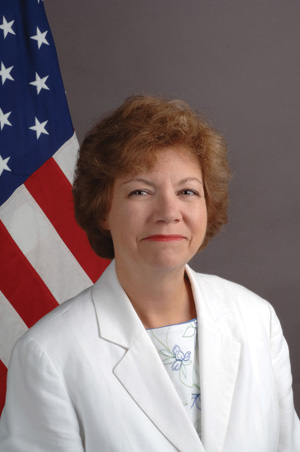
|
Gillian Milovanovic , Kimberley Process chair.
Photo courtesy U.S. Department of State.
|
The Vicenzaoro Fair, usually about high-end jewelry trends
and design, took on a different tone this year by hosting the World Diamond
Council (WDC) annual plenary and the annual congress of CIBJO, the World
Jewellery Confederation. The three events constituted the World Jewellery
Forum, offering high-level discussions on topics ranging from human rights
issues affecting the trade to rising competition from other luxury products,
corporate social responsibility and enhancing value-adding opportunities in the
industry.
It was therefore appropriate that the spring fair adopted a
more international theme emphasizing the global appeal of Italian jewelry
design. “In our globalized economy, promoting one’s own identity and roots is
becoming more and more important,” show organizers said. “Italian jewelry is
therefore called upon to take its contents and products to the world, to
promote the uniqueness of its Italian heritage and to turn it into a truly
distinctive and competitive element.”
That strategy was particularly relevant for businesses
focused on the local and European markets, especially since the stark
undertones of Europe’s economic crisis darkened the mood among traders. “The
market here is quiet,” said Alberto Loloi of Taj Diamonds, an Italy-based
diamond supplier. He explained that depreciation of the euro against the U.S.
dollar, coupled with new Italian government regulations limiting cash purchases
at the retail level, have contributed to the quiet. Italian consumers are
allowed to pay cash only on purchases below 1,000 euros — approximately
$1,260.
Europe’s economic gloom also has changed diamond buying
among Italian jewelry designers, with more of them willing to use less
expensive goods than before. With its strong focus on jewelry, the diamond
pavilion was relatively small at the fair and the participating diamond
companies noted that the show provided more of a networking opportunity “in a
still important market” than a significant selling prospect.
CIBJO TACKLES NEW CHALLENGES
Mindful of the changing consumer landscape, delegates at the
CIBJO Congress were fine-tuning amendments to the organization’s four “blue
books,” which set the standards for the grading, methodology and nomenclature
of diamonds, colored gemstones, pearls and precious metals.
CIBJO also created a number of entities — commissions, work
groups and task forces — to provide added-value services to its members. These
included a trade show commission, a security, insurance and logistics working
group and a coral working group. CIBJO also reactivated its ethics commission.
A new strategic task force, which will be headed by Eli
Avidar, managing director of the Israel Diamond Institute Group of Companies
(IDI), will be charged with increasing CIBJO’s industry membership and
strengthening its financial base, among other things. Gaetano Cavalieri,
CIBJO’s president, explained that the new bodies would help expand the tangible
benefits that its members are able to offer and strengthen CIBJO’s ability to
tackle new and developing challenges facing the jewelry industry.
Avidar noted that the organization has emerged as an
unrivalled umbrella organization, having achieved consultative status at the
United Nations and having established the gems and jewelry industry’s first
center of excellence for education in corporate social responsibility, which is
based in Antwerp. While he admitted the industry is under pressure from other
luxury product sectors and third-party scrutiny, Avidar stressed that CIBJO
ought to take the lead in advocating the industry’s position on issues of
concern.
“It is common knowledge that in some markets — particularly
in North America and Europe — the jewelry retail market has been losing market
share, mainly due to competition from other luxury products, but also due to
loss of consumer confidence,” Avidar said. “There is a lot of room to improve
the industry’s marketing efforts and this is one of the areas where CIBJO
members need help. I think that one of the next challenges CIBJO needs to take
on is the creation of marketing tools that can be used by CIBJO members.”
HUMAN RIGHTS STAND
The depth of scrutiny that the industry faces was evident at
the WDC conference, where the organization hailed a “groundbreaking” expression
of its support for discussions to widen the conflict diamonds definition in the
core documents of the Kimberley Process (KP) beyond its current scope of
diamonds that finance conflict. The plenary session passed a resolution that
conflict diamonds should cover “diamond-related violence in rough diamond
producing and trading areas.”
Prior to the resolution, Alan Martin, research director of
Partnership Africa Canada (PAC), a nonprofit organization dedicated to
promoting sustainable human development in Africa, harshly criticized the WDC’s
“ambiguity” regarding conflict diamonds. When the resolution passed, he praised
it, saying that it offered a clearer message regarding the WDC’s stance.
The discussion leading up to the WDC resolution followed an
announcement by Gillian Milovanovic, chairperson of the KP, that she intends to
propose a new definition of conflict diamonds that would include acts of
violence at the KP June intersessional meeting in Washington, D.C.
While the new definition does not refer to human rights
abuses, Milovanovic told Rapaport Magazine that the definition implied human
rights violations. Our aim is to focus on human development and financial
transparency that will allow the KP to provide technical assistance to affected
people in the trade, such as alluvial miners, which would extend to protecting
their human rights, she added.
Milovanovic stressed that the move to change the definition
was still in the discussion phase. Ultimately, it will be up to governments
participating in the KP to reach full consensus on the issue before the
resolution can pass. “No decision will be made at the intersessional but we
hope to refine the discussion so that a new definition will be implemented in
the near future,” concluded Milovanovic.
Article from the Rapaport Magazine - June 2012. To subscribe click here.